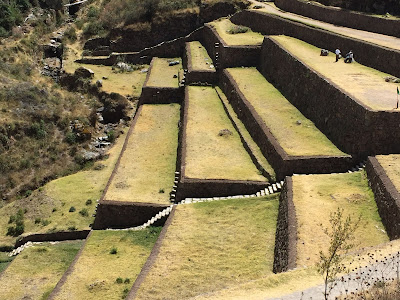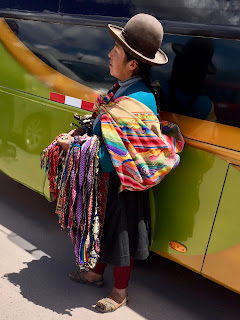We had to rise early (4:45) to catch the flight to Lima and a second one to Cusco. We arrived at our hotel in Cusco around 1pm. We got organized and then headed out for a late lunch. We noted that Cicciolina's "Bodega…Bar de Tapas…Restaurante” is open til 3pm and headed out around 2pm. It took us longer to get there than it might because we were so distracted by the beauty (and the shops) of the city. We were delighted to realize that we had 5 more days (after our visit to Machu Picchu) to enjoy the ambience, shopping and restaurants.
We had to wait 20 minutes for a table, but made the most of the break by sharing a split of Pro Secco and studying the menu. The difficulty was that we wanted pretty much one of everything on the menu which has a mix of international and Peruvian dishes. We finally settled for a "salad of BBQ prawns and calamari drizzled with sweet and spicy chilli sauce sitting on fresh green leaves with mint, toasted peanuts, coriander leaves, avocado and crisp rice noodles" followed by Pat’s "wild mushroom risotto" and Bill’s "gnocchi with parmigiano, sage, butter and truffle aromas". You will be hearing more about this restaurant!!
And for dessert, we chose "chocolate and pecan brownie with peanut butter sauce, 'earth' ground chocolate and lemon grass ice cream."
After lunch we wandered over to the Plaza de Armas (the central square) and got lost in the beauty of the competing churches (the Cathedral and the Jesuit Church which is far more ornate, at least on the outside), the Colonial architecture, and the views of the city as it climbs up the surrounding mountain.
 |
| There are lots of options for taking photos with ladies and baby llamas. |
 |
| We are not sure which church this is but liked the photo op |
As we headed back to our hotel we found a Kuna Alpaca store. At the Lima airport earlier in the day we had found some great travel slippers of alpaca or llama leather and baby alpaca tops. So great. But not available in our sizes. The clerk suggested we try their stores in Cusco. Here we were. And they did have slippers for Bill. There are more Kuna stores in Cusco and Pat was determined to succeed (which she did.)
Nearby Cusco are a number of impressive and notable Inca sites. The most renowned being Machu Picchu. But there are several in the Sacred Valley of the Incas as well. Stretching from the town of Pisac in the east through to Machu Picchu in the west (more than 60 miles). The Incas considered the valley sacred because of its astronomical relation with the Milky Way which at certain times of the year aligns with the valley. Key Inca sites here are:
- The sweeping pre-Colombian agricultural terraces of Pisac that blend into the natural curvature of the hillside. In recent years Pisac has been home to a weekly market. Nowadays the market has turned into a daily market that is the main event.
- A large fortress at Ollantaytambo (a former Inca administrative center). At the time of the Spanish conquest of Peru, Ollantaytambo served as the last stronghold for Inca Manco Yupanqui. It is also the most common starting point for the famous Inca Trail. It was here, in 1536, that a force of Conquistadors was showered with arrows and eventually routed after the Incas used their irrigation system to flood the valley floor, bogging down the horse-riding Spaniards. It was a dramatic stand but only deterred the Spanish briefly.
- The experimental deep circular terraces at Moray (which we had to pass up). With these circular terraces rising over thousands of feet, the Incas experimented to see which crops worked best at which altitudes. Intriguing and we hated to miss it.
Views over the Sacred Valley
Below are a few views over the agricultural terraces at Pisac.
| Local women were waiting in the parking lot to sell their wares. |
Then it was off to the Pisac market. We found a few irresistible items including a baby alpaca sweater for Pat. Pat wandered behind the market and found a cross that appeared to be dressed up. It turns out the local traditions included dressing images of the gods in fine clothing. When the Spaniards forbade this custom, decorating crosses became popular.
For lunch we went to Ulrike’s Cafe. It’s a small place in a small town but the food was excellent and went well with our Cusqueña (the Cusco brand) beers (the first time we had them officially in the district of Cusco). Bill had the alpaca focaccia sandwich and Pat had the vegetarian lasagna. Harry, our guide, ordered a starter of taquenos (small rolled tortilla stuffed with cheese served with guacamole for dipping). He nicely shared. Oh and his name? Well his Dad really liked the Dirty Harry movies. He also likes Santana and apparently Harry & his Dad (a military type) have matching tattoos commemorating a Santana concert they enjoyed together.
We arrived in Ollantaytambo later in the afternoon and settled into our hotel. We shared a pizza for dinner.
 |
| Terraces leading up to the Temple of the Sun. Yep, we climbed up. |
 |
| Ruins of large warehouses built on the mountain. |
 |
| Pat's "fish-eye" view of the massive stones of the temple wall |
 |
| The seemingly odd bumps on the temple wall apparently align perfectly for some astronomical events |
Next we headed off to Huilloc, a local village whose economy is based on agriculture and weaving. The road up was narrow with steep drop-offs causing Pat to have a few worries. But we arrived safely. And Harry reported that the road was vastly better than a few years ago. Glad we waited to visit! Upon arrival, it was interesting to see the locals in native costume. We visited the community cooperative shop and bought a nice weaving.
 |
| Bulls hauling the plows as they prepare the fields for planting |
 |
| Cleaning burrs out of the wool |
 |
| Cute kid |
 |
| In this culture it seems to be all about the hats. Even the design of men's knit hats tell a story. We just can't read it. ;-) |
And then we discovered that a pole extending out from a shop with a red bag on it. It turns out this indicates that their corn beer is ready. We are not sure how long it takes to brew the beer or if they really ever take the poles down, but...interesting.
Dinner was at our hotel. The fish sticks (little fingers of trout) were excellent.
The next morning we were off to Machu Picchu. From Ollaytaytambo, it is a 4 day / 3 night hike to the Sun Gate at Machu Picchu OR a 1:45 train ride to Aquas Calientes followed by a 20 minute bus ride up the precipitous mountainside to the main site. We chose the later approach taking only an overnight bag on the train ride. After checking into our hotel we hopped onto the bus. Thanks to our guide we successfully avoided long lines and were quickly on the site.
Machu Picchu is thought to be the seasonal residence of Pachacutec, the 9th Incan ruler. During his rule, the Inca Empire had reached its highest level of development. The site’s location and the orientation of its most important structures, were strongly influenced by the location of nearby holy mountains. On important days such as the equinox or the soltice, the sun can be seen to rise or set behind nearby mountain peaks.
Our first view over the “urban” part of the site was from near the guards hut, quite impressive in the bright sun. We wandered up, down, around and through the site. Hard to imagine how all this was created. We headed back down knowing we would be back in the morning.
 |
| The stones in the front are shaped to mirror the sacred mountain peaks in the background |
 |
| Cute baby llama |
 |
| Agricultural terraces spanning great heights |
In several places the trail narrows to the width of one person. Thank god for the heavy cable railing added in recent years…without it, we would never have gotten so close to the bridge. The views from the trail are cloud forest, river canyons and mountains. We got a few glimpses in spite of the fog. The hike was well worth the effort, but we would never consider crossing that bridge. Actually it is gated off so we had no choice.
 |
| Yep, that's the trail directly behind Bill. The sign says ""Walk carefully / Narrow Path" |
 |
| The bridge is a little more than 1/3 of the way up this photo and basically in the center from left to right |
 |
| Here's a close-up of the bridge. We just noticed the rocks protruding along the wall beyond the bridge. They are similar to the stone step up terrace walls. We can't imagine when they were used. |
We headed back down to the Aquas Calientes and after a quick snack (pizza), we boarded the train back to Ollantaytambo.
Our driver was waiting with our left bags and we headed to Cusco. We stopped at Chinchero, a picturesque colonial village renowned for its intricate traditional textiles (blankets, shawls, table cloths, bags, etc woven from Alpaca and wool). At the Interpretation Center of Andean Textiles, local women, in traditional Andean dress, provide weaving demonstrations. They also show how the wool is washed, dyed and spun.
 |
| Cochineal bugs are used for a range of red dyes. Here she shows how adding lemon juice changes the color. |
 |
| At one point three women were braiding this one's hair. |
After the demonstration, we wandered around looking at their wares and purchased a lovely, light-weight blanket.
Back in Cusco we made our way down some one lane, bi-directional streets to our apartment. The trip was made all the more challenging because of a procession in the main square which caused rerouting of traffic. After settling in we headed to Pachapapa for dinner, Alpaca skewers with potato, salad. Bill’s came with a stuffed pepper. A nice bottle of Peruvian syrah went quite nicely with these.




















I have enjoyed all these posts and photos. Looks like you are having a wonderful time!
ReplyDelete